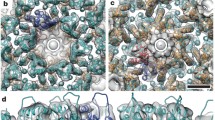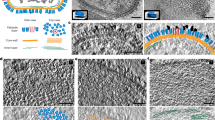Summary
The organization of envelope projections (knobs) of four different isolates of the human immunodeficiency virus types 1 and 2 (HIV-1 and -2) was studied using surface replica and thin section electron microscopy (EM) in combination with rotational image enhancement. All HIV strains show an identical organization of knobs on the virus envelope. The surface of an “ideal”, well-preserved HIV particle is studded with 72 knobs arranged in a T=7 laevo symmetry. The role of the p17 protein, which is coating the inner leaflet of the viral envelope, is discussed as a matrix protein functioning as a scaffold for the envelope and its projections during morphogenesis as well as with mature virions.
Similar content being viewed by others
References
Caspar DLD, Klug A (1962) Physical principles in the construction of regular viruses. In: Basic Mechanisms in Animal Virus Biology. Cold Spring Harbor Symp Quant Biol 27: 1–24
Clavel F, Guyader M, Guétard D, Sallé M, Montagnier L, Alizon M (1986) Molecular cloning and polymorphism of the human immune deficiency virus type 2. Nature 324: 691–695
Cheng-Mayer C, Rutka JT, Rosenblum ML, McHugh T, Stites DP, Levy JA (1987) Human immunodeficiency virus can productively infect cultured human glial cells. Proc Natl Acad Sci USA 84: 3526–3530
Finch JT, Holmes KC (1967) Structural studies of viruses. In: Maramorosch K, Koprowski H (eds) Methods in virology, vol 3. Academic Press, New York London, pp 351–474
Frank H, Schwarz H, Graf T, Schäfer W (1978) Properties of mouse leukemia viruses. XV. Electron microscopic studies on the organization of Friend leukemia virus and other mammalian C-type viruses. Z Naturforsch 33c: 124–138
Fuller SD (1987) The T=4 envelope of Sindbis virus is organized by interactions with a complementary T=3 capsid. Cell 48: 923–934
Gelderblom H, Özel M, Pauli G (1985a) T-Zell-spezifische Retroviren des Menschen: Vergleichende morphologische Klassifizierung und mögliche funktionelle Aspekte. Bundesgesundheitsbl 28: 161–171
Gelderblom H, Reupke H, Pauli G (1985b) Loss of envelope antigens of HTLV-III/LAV, a factor in AIDS pathogenesis? Lancet ii: 1016–1017
Gelderblom HR, Hausmann EHS, Özel M, Pauli G, Koch MA (1987) Fine structure of human immunodeficiency virus (HIV) and immunolocalization of structural proteins. Virology 156: 171–176
Gelderblom HR, Özel M, Hausmann EHS, Winkel T, Pauli G, Koch MA (1988) Fine structure of human immunodeficiency virus (HIV), immunolocalization of structural proteins and virus-cell relation. Micron 19 (in press)
Gonda MA, Wong-Staal F, Gallo RC, Clements JE, Narayan O, Gilden RV (1985) Sequence homology and morphologic similarity of HTLV-III and visna virus, a pathogenic lentivirus. Science 227: 173–177
Gonda MA, Braun MJ, Clements JE, Pyper YM, Wong-Staal F, Gallo RC, Gilden RV (1986) Human T-cell lymphotropic virus type III shares sequence homology with a family of pathogenic lentiviruses. Proc Natl Acad Sci USA 83: 4007–4011
Guyader M, Emermann M, Sonigo P, Clavel F, Montagnier L, Alizon M (1987) Genome organization and transactivation of the human immunodeficiency virus type 2. Nature 326: 662–669
Hohenberg H, Mannweiler K, Bohn W, Andresen I, Schröder S (1980) Routine preparation of large surface replicas of freeze-fractured and critical point-dried cell cultures grown on coverslips for hight resolution electron microscopy. Electron Microsc 2: 730–731
Liljas L (1986) The structure of spherical viruses. Prog Biophys Mol Biol 48: 1–36
Markham R, Frey S, Hills GJ (1963) Methods for the enhancement of image detail and accentuation of structure in electron microscopy. Virology 20: 88–102
Marx PA, Munn RJ, Munn KI (1988) Computer emulation on thin-section electron microscopy predicts an envelope-associated icosadeltahedral capsid for human immunodeficiency virus. Lab Invest 58: 112–120
Mattern CFT (1977) Symmetry in virus architecture. In: Nayak DP (ed) The molecular biology of animal viruses, vol 1. Marcel Dekker, New York Basel, pp 1–40
Nermut MV, Frank H, Schäfer W (1972) Properties of mouse leukemia viruses. III. Electron microscopic appearance as revealed after conventional preparation techniques as well as freeze-drying and freeze-etching. Virology 49: 345–358
Özel M, Gelderblom H (1985) Capsid symmetry of viruses of the proposed Birnavirus group. Arch Virol 84: 149–161
Özel M, Pauli G, Gelderblom H (1987) The organization of HIV envelope proteins. Eur J Cell Biol 44 [Suppl] 19: 41
Palmer E, Sporborg C, Harrison A, Martin ML, Feorino P (1985) Morphology and immunoelectron microscopy of AIDS virus. Arch Virol 85: 189–196
Palmer E Goldsmith CS (1988) Ultrastructure of Human Tetroviruses. J Electron Microsc Tech 8: 3–17
Pettersson R, Kääriäinen L, von Bonsdorff C-H, Okerblom N (1971) Structural components of Uukuniemi virus, a noncubical tick-borne arbovirus. Virology 46: 721–729
Sarkar NH, Moore DH (1974) Surface structure of mouse mammary tumor virus. Virology 61: 38–55
Simionescu N, Simionescu M (1976) Galloylglucose of low molecular weight as mordant in electron microscopy. J Cell Biol 70: 608–621
Simons K, Garoff H (1980) The budding mechanisms of enveloped animal viruses. J Gen Virol 50: 1–20
Sommer JR (1977) To cationize glass. J Cell Biol 75: 245a
Venable JH, Coggeshall R (1965) A simplified lead citrate stain for use in electron microscopy. J Cell Biol 25: 407–408
Vogel H, Provencher SW, von Bonsdorff C-H, Adrian M, Dubochet J (1986) Envelope structure of Semliki Forest virus reconstructed from cryo-electron micrographs. Nature 320: 533–535
von Bonsdorff C-H, Harrison SC (1975) Sindbis virus glycoproteins form regular icosahedral surface lattice. J Virol 16: 141–145
von Bonsdorff C-H, Harrison SC (1978) Hexagonal glycoprotein arrays from Sindbis virus membranes. J Virol 28: 578–583
von Bonsdorff C-H, Pettersson R (1975) Surface structure of Uukuniemi virus. J Virol 16: 1296–1307
Williams RC, Smith KM (1958) The polyhedral form of the Tipula Iridescent virus. Biochim Biophys Acta 28: 464–469
Author information
Authors and Affiliations
Additional information
Dedicated to Professor Dr. Georg Henneberg on occasion of his 80th birthday.
Rights and permissions
About this article
Cite this article
Özel, M., Pauli, G. & Gelderblom, H.R. The organization of the envelope projections on the surface of HIV. Archives of Virology 100, 255–266 (1988). https://doi.org/10.1007/BF01487688
Received:
Accepted:
Issue Date:
DOI: https://doi.org/10.1007/BF01487688




